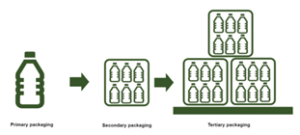Introduction
Secondary & Tertiary Packaging
This guide addresses secondary and tertiary packaging widely used for produce and food. This site explains the three main packaging levels. A typical understanding of the levels:
- Primary: contains and contacts the product; always goes home with consumer.
- Secondary: contains a group of products; sometimes retail-ready; sometimes goes home with consumer; also used in e-commerce, sometimes branded (e.g., folding cartons, boxes, trays, pouches, shrink wrap, separators, cushioning).
- Tertiary: contains/transports larger quantities of products during shipping (e.g., larger boxes, pallets, stretch wrap and adhesive tape).

It’s important to consider packaging sustainability in terms of a product-packaging system. For example, too much reduction of primary packaging may increase the need for more secondary or tertiary packaging – this is called burden-shifting, and may offset primary package impact reductions. Along with the quantity of materials used, burden-shifting may also include impacts on logistical efficiency. For example, changes to the size and/or shape of the primary package can impact palletization and cube utilization.
Also worth noting is that governments may define packaging levels slightly differently. For example, primary packaging may include any packaging that goes home with the consumer, even if it does not directly contact the product. Differences like this may impact regulatory requirements for elements such as recycled content.
Sustainable Packaging Options & Uses Cases
Supporting Resources – Rigid PET specific
General Information
- Understanding Cube Utilization 2017
IFCOSummary of Cube Utilization for fresh produce industry.
- Stretch Wrap Alternatives 2021
CHEPIn January 2021, the Ellen MacArthur Foundation initiated the Stretch Wrap Alternative Project (SWAP) — including ten companies from its network, to test a commercially viable and geographically scalable circular alternatives to linear stretch wrap, focusing on reuse, recycling, and composting.
- Reusable Plastic Packaging in B2B 2016
Ellen MacArthur FoundationApplying circular economy principles to global plastic packaging flows could transform the plastics economy and drastically reduce negative externalities such as leakage into oceans, according to this new report.
The New Plastics Economy: Rethinking the future of plastics provides, for the first time, a vision of a global economy in which plastics never become waste, and outlines concrete steps towards achieving the systemic shift needed.